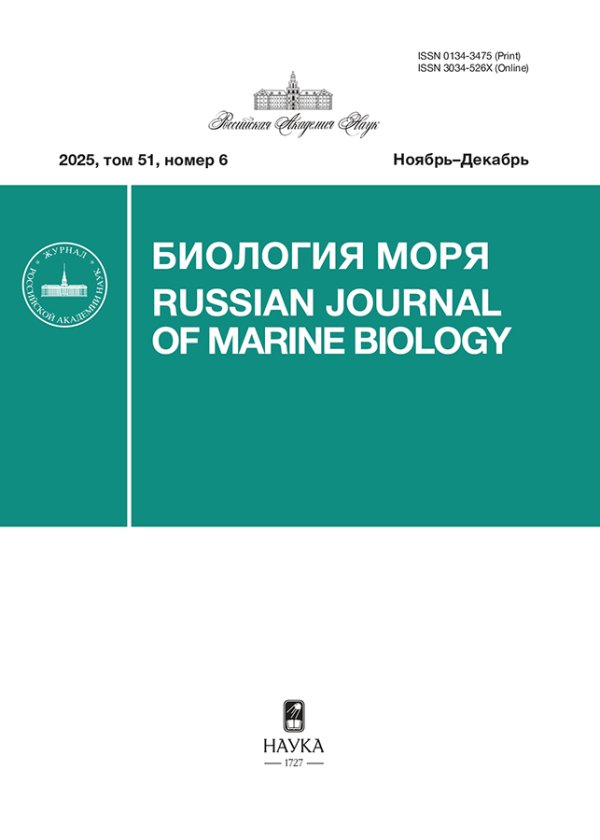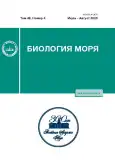Assessment of Microplastic Degradation in Bottom Sediments Using Raman Microspectroscopy and Atomic Force Microscopy
- Authors: Karpenko A.A.1, Odintsov V.S.1
-
Affiliations:
- Zhirmunsky National Scientific Center of Marine Biology, Far Eastern Branch, Russian Academy of Sciences
- Issue: Vol 49, No 4 (2023)
- Pages: 236-244
- Section: ОРИГИНАЛЬНЫЕ СТАТЬИ
- Published: 01.07.2023
- URL: https://journal-vniispk.ru/0134-3475/article/view/135140
- DOI: https://doi.org/10.31857/S0134347523040058
- EDN: https://elibrary.ru/UOFCZL
- ID: 135140
Cite item
Full Text
Abstract
The assessed degradation of microplastics from bottom sediments of the Laptev Sea, the Weddell Sea, the Chukchi Sea and Peter the Great Bay, Sea of Japan, was studied using Raman microspectroscopy and atomic force microscopy (AFM). The degree of amorphous-crystallinity of polyethylene terephthalate (PET) was determined by the ratio of Raman mode intensities (I1095 cm–1 / I1115 cm–1). Changes in the topography and mechanical properties of the surface of polymer fragments were studied by AFM methods. It has been shown that the degradation of PET found in the bottom sediments of the Laptev Sea affects mainly its crystalline phase. The amorphous phase of PET is affected to a much lesser extent or not at all. The same changes in the phase composition of the PET surface have been shown after plastic exposure in a marine aquarium in silty sand from the Amur Bay (Peter the Great Bay, Sea of Japan). AFM data show an increase in PET surface roughness and a decrease in elasticу modulus (Young’s modulus) in bottom sediment samples. Raman microspectroscopy also shows signs of degradation of cellophane fragments from the Weddell Sea, polyvinyl chloride (PVC) from the Laptev Sea, and polyethylene (PE) from the Amur Bay.
About the authors
A. A. Karpenko
Zhirmunsky National Scientific Center of Marine Biology, Far Eastern Branch, Russian Academy of Sciences
Email: slavodin@inbox.ru
Russia, 690041, Vladivostok
V. S. Odintsov
Zhirmunsky National Scientific Center of Marine Biology, Far Eastern Branch, Russian Academy of Sciences
Author for correspondence.
Email: slavodin@inbox.ru
Russia, 690041, Vladivostok
References
- Adar F., Noether H. Raman microprobe spectra of spin-oriented and drawn filaments of poly(ethylene terephtha-late) // Polymer. 1985. V. 26. № 13. P. 1935–1943.
- Al-Dossary A.K., Gilbert M., Hitt D. Evaluating PVC degradation using UV and Raman spectroscopies // Advanced Materials Research. 2010. V. 83–86. P. 923–930. https://doi.org/10.4028/www.scientific.net/AMR.83-86.923
- Auta H.S., Emenike C.U. Screening of Bacillus strains isolated from mangrove ecosystems in Peninsular Malaysia for microplastic degradation // Environ. Pollut. 2017. V. 231. № 2. P. 1552–1559. https://doi.org/10.1016/j.envpol.2017.09.043
- Auta H.S., Emenike C.U., Fauziah S.H. Distribution and importance of microplastics in the marine environment: a review of the sources, fate, effects, and potential solutions // Environ. Int. 2017. V. 102. P. 165–176.https://doi.org/10.1016/j.envint.2017.02.013
- Barrett J., Chase Z., Zhang J. et al. Microplastic Pollution in Deep-Sea Sediments From the Great Australian Bight // Front. Mar. Sci. 2020. V. 7. 576170. https://doi.org/10.3389/fmars.2020.576170
- Bergmann M., Wirzberger V., Krumpen T. et al. High quantities of microplastic in Arctic deep-sea sediments from the HAUSGARTEN observatory // Environ. Sci. Technol. 2017. V. 51. № 19. P. 11000–11010. https://doi.org/10.1021/acs.est.7b03331
- Browne M.A., Crump P., Niven S.J. et al. Accumulation of microplastic on shorelines woldwide: sources and sinks // Environ. Sci. Technol. 2011. V. 45. № 21. P. 9175–9179. https://doi.org/10.1021/es201811s
- Cedervall T., Hansson L.-A., Lard M. et al. Food chain transport of nanoparticles affects behaviour and fat metabolism in fish // PLoS One. 2012. V. 7. № 2. e32254. https://doi.org/10.1371/journal.pone.0032254
- Danso D., Schmeisser C., Chow J. et al. New insights into the function and global distribution of polyethylene terephthalate (PET) – degrading bacteria and enzymes in marine and terrestrial metagenomes // Appl. Environ. Microbiol. 2018. V. 84. e02773-02717. https://doi.org/10.1128/AEM.02773-17
- Fechine G.J.M., Rabello M.S., Souto-Maior R.M. The effect of ultraviolet stabilizers on the photodegradation of poly(ethylene terephthalate) // Polymer Degradation and Stability. 2002. V. 75. № 1. P. 153–159. https://doi.org/10.1016/s0141-3910(01)00214-2
- Haegerbaeumer A., Mueller M.-T., Fueser H., Traunspurger W. Impacts of Micro- and Nano-Sized Plastic Particles on Benthic Invertebrates: A Literature Review and Gap Analysis // Front. Environ. Sci. 2019. V. 7. № 17. https://doi.org/10.3389/fenvs.2019.00017
- Harrison J.P., Sapp M., Schratzberger M., Osborn A.M. Interactions Between Microorganisms and Marine Microplastics: A Call for Research // Mar. Technol. Soc. J. 2011. V. 45. № 2. P. 12–20. https://doi.org/10.4031/MTSJ.45.2.2
- Hiejima Y., Kida T., Takeda K. et al. Microscopic structural changes during photodegradation of low-density polyethylene detected by Raman spectroscopy // Polymer Degradation and Stability. 2018. V. 150. P. 67–72. https://doi.org/10.1016/j.polymdegradstab.2018.02.010
- Hermabessiere L., Dehaut A., Paul-Pont I. et al. Occurrence and effects of plastic additives on marine environments and organisms: a review // Chemosphere. 2017. V. 182. P. 781–793. https://doi.org/10.1016/j.chemosphere.2017.05.096
- Hiraga K., Taniguchi I., Yoshida S. et al. Biodegradation of waste PET: A sustainable solution for dealing with plastic pollution // EMBO reports. 2019. V. 20. № 11. P. e49365. https://doi.org/10.15252/embr.201949365
- Hirai H., Takada H., Ogata Y. et al. Organic micropollu-tants in marine plastics debris from the open ocean and remote and urban beaches // Mar. Pollut. Bull. 2011. V. 62. № 8. P. 1683–1692. https://doi.org/10.1016/j.marpolbul.2011.06.004
- Kane I.A., Clare M.A., Miramontes E. et al. Seafloor microplastic hotspots controlled by deep-sea circulation // Science. 2020. V. 368 (6495). https://doi.org/10.1126/science.aba5899
- Koelmans A.A., Kooi M., Law K.L., van Sebille E. All is not lost: Deriving a top-down mass budget of plastic at sea // Environ. Res. Lett. 2017. V. 12. 114028. https://doi.org/10.1088/1748-9326/aa9500
- Kuznetsov S.M., Sagitova E.A., Prokhorov K.A. et al. Raman spectroscopic detection of polyene-length distribution for high-sensitivity monitoring of photo- and thermal degradation of polyvinylchloride // Spectrochimica Acta. Part A: Molecular and Biomolecular Spectroscopy. 2021. V. 252. 119494. https://doi.org/10.1016/j.saa.2021.119494
- Lin C.C., Krommenhoek P.J., Watson S.S. et al. Depth profiling of degradation of multilayer photovoltaic backsheets after accelerated laboratory weathering: Cross-sectional Raman imaging // Solar Energy Materials and Solar Cells. 2016. V. 144. P. 289–299.
- Lippert T., Zimmermann F., Wokaun A. Surface analysis of excimer-laser- treated polyethylene-terephthalate by surface-enhanced Raman scattering and X-ray photo electron spectroscopy // Appl.Spectrosc. 1993. V. 47. P. 1931–1942.
- Lusher A.L., Tirelli V., O’Connor I. et al. Microplastics in Arctic polar waters: the first reported values of particles in surface and sub-surface samples // Scientific reports. 2015. V. 5. P. 14947. https://doi.org/10.1038/srep14947
- Lwanga E.H., Thapa B., Yang X. et al. Decay of low-density polyethylene by bacteria extracted from earthworm’s guts: A potential for soil restoration // Sci. Total Environ. 2018. V. 624. P. 753–757. https://doi.org/10.1016/j.scitotenv.2017.12.144
- Odintsov V.S., Karpenko A.A., Karpenko M.A. Degradation of micro‑nano‑sized polytetrafluoroethylene and acrylic fluorinated copolymer particles in the periwinkle digestive tract // Environ. Sci. Pollut. Res. Int. 2022. https://doi.org/10.1007/s11356-022-23996-5
- Peeken I., Primpke S., Beyer B. et al. Arctic sea ice is an important temporal sink and means of transport for microplastic // Nature communications. 2018. V. 9. № 1. P. 1–12. https://doi.org/10.1038/s41467-018-03825-5
- Planes E., Yrieix B., Bas C. et al. Chemical degradation of the encapsulation system in flexible PV panel as revealed by infrared and Raman microscopies // Solar Energy Materials and Solar Cells. 2014. V. 122. P. 15–23.
- Trevail A.M., Gabrielsen G.W., Kühn S. et al. Elevated levels of ingested plastic in a high Arctic seabird, the northern fulmar (Fulmarus glacialis) // Polar Biology. 2015. V. 38. № 7. P. 975–981. https://doi.org/10.1007/s00300-015-1657-4
- Webb H.K., Arnott J., Crawford R.J. et al. Plastic degradation and its environmental implications with special refe-rence to poly(ethylene terephthalate) // Polymers. 2013. V. 5. № 1. P. 1–18. https://doi.org/10.3390/polym5010001
- Wayman C., Niemann H. The fate of plastic in the ocean environment – a minireview // Environ. Sci.: Processes Impacts. 2021. V. 23. 198–212. https://doi.org/10.1039/d0em00446d
- Zhang J., Zhao Y., Li L. et al. Biodegradation of polye-thylene microplastic particles by the fungus Aspergillus flavus from the guts of wax moth Galleria mellonella // Sci. Total. Environ. 2020. V. 704. 135931. https://doi.org/10.1016/j.scitotenv.2019.135931
- Zobkov M., Esiukova E. Microplastics in Baltic bottom se-diments: Quantification procedures and first results // Marine Pollution Bulletin. 2017. V. 114. P. 724–732. https://doi.org/10.1016/j.marpolbul.2016.10.060
Supplementary files
















